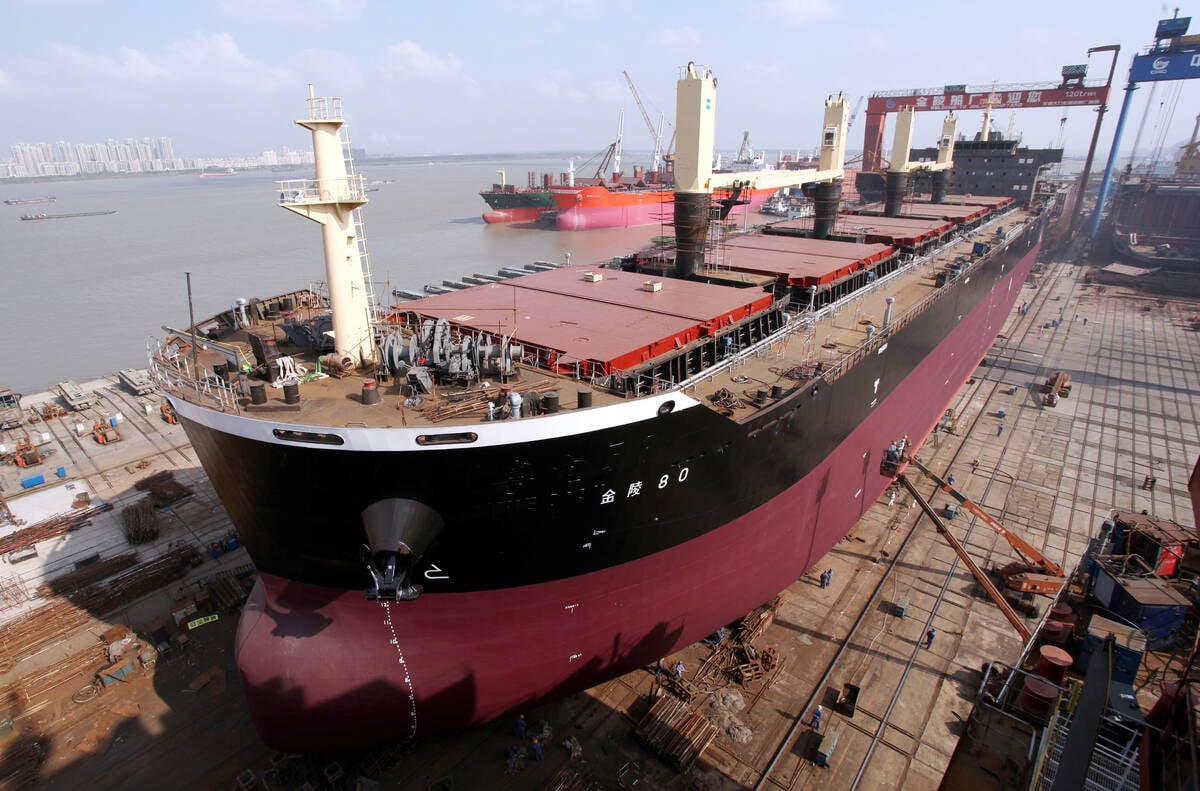SASKATOON — Proposed fees on Chinese-built and -operated ships will make exports from the United States less competitive in the world market, and that would greatly benefit Canadian shippers, says an analyst.
“Absolutely,” said MarketsFarm analyst Bruce Burnett.
“I personally would love to see them shoot themselves in their foot like this.”
Read Also

Exports off to a slow start after last year’s torrid pace
Canadian grain, oilseed and pulse exports are off to a slow start, but there are some bright spots, according to the Canadian Grain Commission’s most recent weekly export data report.
The U.S. Trade Representative is proposing fees of up to $1 million per entrance on Chinese-operated vessels and $1.5 million on Chinese-built vessels.
There will also be a gradual requirement to shift a growing percentage of U.S. exports onto U.S.-flagged and U.S.-built vessels.
The USTR’s objective is to shift momentum in the shipbuilding sector from China to the moribund U.S. industry.
But the American Farm Bureau (AFB) said the measures would impose significant near-term costs on U.S. agriculture and “strangle” trade down the road.
“Farmers and ranchers, already operating on tight margins, would face higher freight rates, reduced competitiveness and potential loss of market share, all while U.S. shipbuilding capacity remains years away from scaling up,” the bureau said in a press release.
United Grain Corp said the proposed fees have already sent bulk shipping costs for wheat, corn and soybeans up 40 percent, according to a Reuters story.
Burnett said the proposal would essentially reduce the number of vessels that U.S. shippers could charter on any trade route.
“That lack of competition just increases the freight rate for U.S. suppliers,” he said.
“It would certainly be positive for Canadian shippers because we’d have lower shipping costs than what a U.S. supplier would.”
U.S. corn exports would probably still be competitive because the country is the lowest-cost producer of that crop in the world.
But it would cause carnage for U.S. soybean and wheat shippers.
A study by Trade Partnership Worldwide found that the proposed fees would cause U.S. soybean exports to tumble by as much as 42 percent, while wheat could plummet 64 percent, according to Reuters.
The USTR recently held two days of public hearings on the proposal where it heard feedback from many organizations, including farm groups.
Mike Koehne, a director of the American Soybean Association, said the proposal creates unintended consequences for farmers.
“We have already seen negative impacts on the futures prices for soybeans because of market reactions to this proposal,” he said.
Koehne said the proposal would “significantly increase freight rates,” making U.S. soybeans less desirable than beans from Brazil and Argentina.
“While well-intended, this proposal would ensure U.S. soybeans will bear higher costs and be less competitive in the global marketplace,” he said.
Chris Bliley, senior vice president of regulatory affairs with Growth Energy, the nation’s largest biofuel trade association, said the proposal will decrease demand for U.S. biofuel exports and raise the price of imported feedstocks.
“At the same time, other countries are taking actions to ease the cost of trade and expand their ethanol exports,” he said.
Bliley asked the USTR to scrap the proposal.
“These new requirements would cause a significant upheaval that American producers can ill afford,” he said.
The AFB said the fees may “unintentionally and disproportionally” penalize U.S. farmers and ranchers.
The U.S. exported over 106 million tonnes of bulk agricultural products in 2024. That represents 1,770 vessel movements per year, assuming an average vessel capacity of 60,000 tonnes.
Over 21 percent of all the vessels calling at U.S. ports that year were Chinese-built.
“Applying the 21 percent figure for Chinese-built vessels translates to about 372 vessel trips per year facing the proposed fees,” stated the bureau.
That means bulk agricultural exporters in the U.S. could face an additional $372 million to $930 million in annual transportation costs depending on whether the $1 million fee on Chinese-operated vessels, the $1.5 million fee on Chinese-built vessels, or both fees are cumulatively applied.
“On a per-unit basis, these fees translate to an increase of 9.5 to 27.75 cents per bushel of soybeans,” said the bureau.
That is a substantial blow in a global market where competitiveness is often determined by pennies per bushel, it stated.
Containerized agricultural exports, which account for 30 percent of U.S. waterborne agricultural exports, would not feel the same level of impact.
That is because those costs will likely be borne by Chinese exporters since container ships often arrive in the U.S. full and return to Asia empty or only partially loaded.
But higher container costs could raise input costs for farmers since many of the inputs they use arrive in containers from China.
The USTR proposal also includes a requirement that a growing percentage of U.S. exports be transported on U.S.-flagged and U.S.-built vessels.
The schedule starts at one percent and rises to 15 percent after seven years.


















